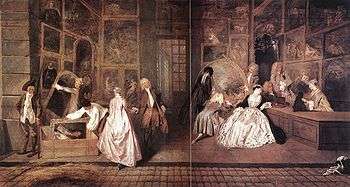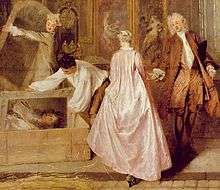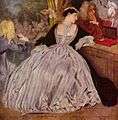L'Enseigne de Gersaint
L'Enseigne de Gersaint (transl. "The Shop Sign of Gersaint") is an oil on canvas painting in the Charlottenburg Palace in Berlin, by French painter Jean-Antoine Watteau. Completed during 1720–21,[1] it is considered to be the last prominent work of Watteau, who died some time after. It was painted as a shop sign for the marchand-mercier, or art dealer, Edme François Gersaint.[2] According to Daniel Roche the sign functioned more as an advertisement for the artist than the dealer.[3]
| L'Enseigne de Gersaint | |
|---|---|
 | |
| Artist | Jean-Antoine Watteau |
| Year | 1720-21 |
| Medium | Oil on canvas |
| Dimensions | 163 cm × 308 cm (64 in × 121 in) |
| Location | Charlottenburg Palace, Berlin |
The painting exaggerates the size of Gersaint's cramped boutique, hardly more than a permanent booth with a little backshop, on the medieval Pont Notre-Dame, in the heart of Paris, both creating and following fashion as he purveyed works of art and luxurious trifles to an aristocratic clientele.[4]
Content

The picture was originally painted on one canvas, depicting clients and staff at the shop. As a worker packs away a portrait of Louis XIV at the left, in the centre a young man offers his hand to a woman who is stepping over the threshold of the shop. At the right an elderly couple examine a painting of nudes, and a pretty young shop assistant, possibly Gersaint's wife, shows a painting to a group of well-dressed young people. In its present form, the painting consists of two separate parts, the upper sections of them were added between 1720 and 1732 by an unknown painter to transform the painting from its original, arched shape into a rectangular field. Watteau probably painted the work in the spring of 1720 when the entire entrance facade of Gersaint's shop was rebuilt. According to the study by Vogtherr and Wenders de Calisse (2007) the painting had originally covered the round field above the entrance of the shop. These changes to the building were made in the spring of 1720, the most likely date for the painting.
The artworks in the painting are set alongside the actions of high-society criticism. The young man offering his hand to the woman in pink is set against a series of female nudes, while puritanical figures in portraits at the left seem to look down disapprovingly. At the right, there are numerous images of orgies and naked figures, implying that art expresses the hidden lustful feelings of the genteel figures in the shop, who merely gaze at one another or engage in polite gestures of intimacy.
Commonly, the painting is interpreted as a commentary on the shift in aristocratic culture – or relief – that occurred during the government of the more licentious Régent Philippe II, Duke of Orléans (1715–1723), after the death of Louis XIV and before the accession to the throne of Louis XV. The boxing of Pierre Mignard's portrait of the deceased king implies the end of the old régime.
Provenance
The painting never actually functioned as an external shop sign, spending only fifteen days at the shop. Watteau himself asked Gersaint to allow him to paint it, complaining of "cold fingers" that needed some exercise.[5] It was soon bought by Claude Glucq. It was then acquired by Watteau's patron Jean de Jullienne.[5][6] An engraving was made in 1732 after a small version by Pater who extended Watteau's composition for the print. It attracted the attention of Frederick the Great of Prussia. He bought the painting in 1748 (at that time already in two separate parts) from the Dutch dealer Pieter Boetgens. It remained in Germany thereafter, now forming part of the collection of the Stiftung Preußische Schlösser und Gärten Berlin-Brandenburg that display it at the Charlottenburg Palace, Berlin where it had first been displayed in 1748.
Details
 Detail
Detail Detail
Detail Detail (possibly Claude Glucq and Mme Gersaint)
Detail (possibly Claude Glucq and Mme Gersaint)
References
- Craske, Matthew (1997). Art in Europe 1700–1830: A History of the Visual Arts in an Era of Unprecedented Urban Economic Growth. Oxford: Oxford University Press. p. 175. ISBN 0192842064.
- Bazin, Germain (1964). Baroque & Rococo. Translated by Jonathan Griffin. London: Thames & Hudson. p. 197. ISBN 0500200181.
- Of the enseigne, "Elle ne fait pas publicité de Gersaint, mais celle de Watteau", Daniel Roche observes in his preface to Guillaume Glorieux's monograph, À l'Enseigne de Gersaint: Edme-François Gersaint, marchand d'art sur le Pont Notre-Dame, Paris, 2002; of Gersaint, Glorieux remarks at the outset, "immortalisé par le chef-d'oeuvre de Watteau, Gersaint est célèbre mais on ne sait presque rien de lui."
- "Gersaint, faiseur de modes, suiveur de modes, est, d'une autre façon que Watteau, un créateur vrai", remarks Daniel Roche in his preface to Glorieux 2002:v.
- T. C. W. Blanning (2003). The Culture of Power and the Power of Culture: Old Regime Europe 1660–1789. Oxford University Press. p. 105.
- Grasselli et al. 1984, p. 450.
Bibliography
- Adhemar, Helene (1964). "L'Enseigne de Gersaint. Aperçus Nouveaux". Bulletin du laboratoire du musee du Louvre (9): 7–16.CS1 maint: ref=harv (link)
- Aragon, Loius (1946). L'Enseigne de Gersaint: Hors-texte de Watteau. Neuchâtel, Paris: Ides et Calendes.
- Camesasca, Ettore, ed. (1971). The Complete Painting of Watteau (loan required). Classics of the World's Great Art. Introduction by John Sutherland. New York: Harry N. Abrams. pp. 126–127. ISBN 0810955253. OCLC 143069 – via the Internet Archive. Cat. no. 212.
- Grasselli, Margaret Morgan; Rosenberg, Pierre & Paramantier, Nicole (1984). Watteau, 1684-1721 ; National Gallery of Art, June 17—September 23, 1984; Galeries Nationales du Grand Palais, Paris, October 23, 1984—January 28, 1985; Schloss Charlottenburg, Berlin, February 22—May 26, 1985. Washington: National Gallery of Art. ISBN 0-89468-074-9. OCLC 557740787 – via the National Gallery of Art archive.
- Licht, Fred (Spring 1994). "Gersaint's Shop Sign". Source: Notes in the History of Art. The University of Chicago Press. 13 (3): 36–38. JSTOR 23204894.
- Maurel, André (1913). L'enseigne de Gersaint : étude sur le tableau de Watteau, son histoire, les controverses, solution du problème. Paris: Hachette – via the Internet Archive.CS1 maint: ref=harv (link)
- Plax, Julie Anne (2000). Watteau and the Cultural Politics of Eighteenth-Century France. Cambridge etc.: Cambridge University Press. ISBN 0-521-64268-X. OCLC 803847893.CS1 maint: ref=harv (link)
- Vidal, Mary (1992). Watteau's Painted Conversations: Art, Literature, and Talk in Seventeenth- and Eighteenth-Century France. New Haven, London: Yale University Press. ISBN 0-300-05480-7.CS1 maint: ref=harv (link)
- Vogtherr, Christoph Martin & Wenders De Calisse, Eva (May 2007). "Watteau's 'Shopsign': The Long Creation of a Masterpiece". The Burlington Magazine. 149 (1250): 296–304. JSTOR 20074823.